1lumen selects and reviews products personally. We may earn affiliate commissions through our links, which help support our testing.
Killzone BLF348 review
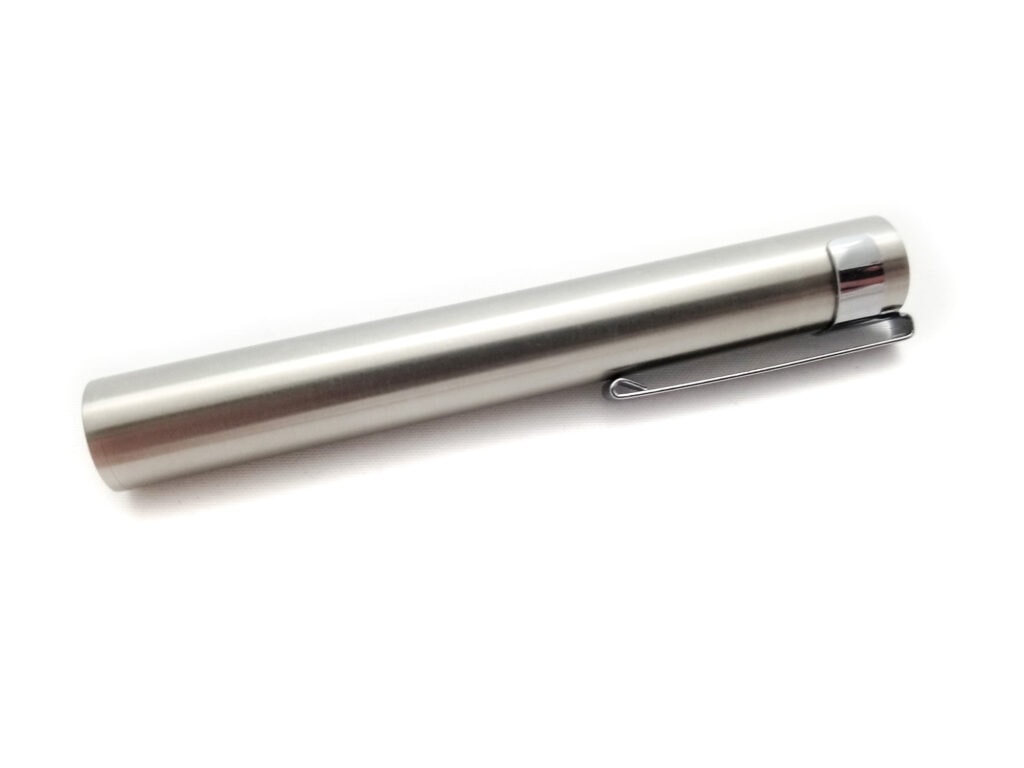
KillzoneFlashlights BLF348 stainless pen light specs
| Brand & Model | Killzone Flashlights Stainless Penlight (BLF348) |
|---|---|
| Flashlight category | Penlight |
| LED | Nichia 519A SM455 M500 L5 R9080 |
| Max. output | 175 lumens (on 10440 li-ion) |
| Max. beam distance | ? |
| Max. beam intensity | ? |
| Battery config. | 1×10440 li-ion, AAA Alkaline or NiMH |
| Onboard charging | None |
| Modes | 1 |
| Blinkies | None |
| Waterproof | ? |
| Review publication date | April 2023 |
Review intro:
If you’re looking for a flashlight or portable illumination tool in 2023, there’s a nearly inexhaustible product base to sample from. The technology factor has arisen to a point where flashlights have bluetooth now, and a pocket light can reach 1500 meters thanks to LEP technology, and we can’t forget Anduril 2, for those who absolutely, positively, must partake in next-level flashlight tinkering.
What’s a guy or gal gotta do to ssslloowww down and get back to the basics, back to when flashlights were a tube with a battery inside, a switch, simple driver, bulb or LED, reflector, and that’s it? Click it on and go. No internal charging, no Andurils, no chargers, no muss, no fuss?
Well, if you identify with that demographic, then I submit to you the light riding in my pocket as I write this, but before we move on, let’s go back in time a bit. Those who hung around the BudgetLightForum back in late 2015 might remember forum member _the_, who collaborated with a Chinese company called SingFire. SingFire made a flashlight dubbed the SF-348, which was a single AAA multi-chemistry pen light made from stainless steel with a pocket clip, one mode UI, and a Cree XP-E or XP-G LED. The objective? To get SingFire to stick one of the most beloved enthusiast LEDs (at the time) into their SF-348, add a little engraving with the BLF logo, and sell it in a group buy courtesy of GearBest.
Well, the rest is history and the SF-348 became the BLF-348. While the internals were unchanged, the light featured the Nichia 219B 5000K 90CRI emitter (aka NVSW219B-V1 sw50 R9050), and to say it was a hit was an understatement since it sold out very quickly, and it’s become sort of an icon in the BLF continuum. Next to the FW3A, it was probably the most popular BLF collab light. Well, time marches on, and SingFire went on to other things, but the light has survived through the years, passing through various vendors under different brandings, but it’s essentially the same. In 2018 Texas-based flashlight reseller Killzone Flashlights acquired a new batch of the BLF348 and started selling it with the Nichia 219C LED, and in 2022, gave it a new LED. It’s of course a Nichia, and it still has all the charm and simplicity of the original as well. The name’s changed a bit to the Killzone Flashlights Stainless Pen Light, but for nostalgia’s sake, we’ll call it the Killzone Flashlights BLF348. I’m super-excited to test on this thing and sample a bit of BLF history. I love nostalgia!
Package quality.
No surprise. I wasn’t expecting a fancy box and I didn’t get one. The packaging is indicative of a low-cost Chinese flashlight, and the Killzone BLF348 came in a predictably low-rent package. It’s a simple white card stock box. Inside is the light in bubble wrap. Nothing else.
- Killzone BLF348 flashlight
No battery, no o-rings, no lanyard, nada. It would have been nice if it included an Alkaline AAA to get started, but no dice.
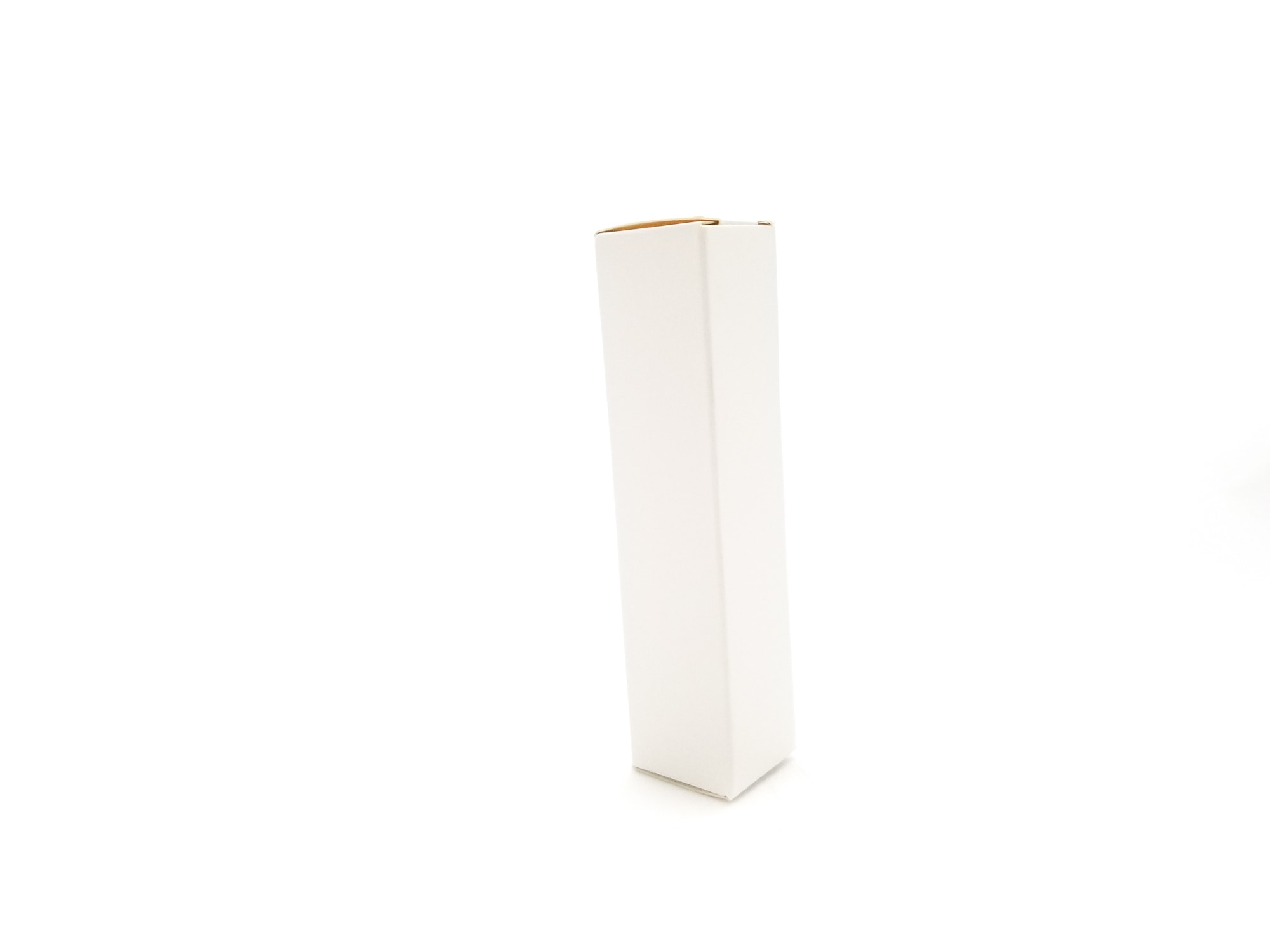
Flashlight in use
This is an elegant, simple to use pocket light. You can stick it in your shirt pocket, pants pocket, hidden pocket in your shorts. EDC it, drill a hole in the pocket clip and thread in a lanyard or key ring even. Flip the pocket clip around and stick it on your ballcap bill or sleeve for hand-free action. It’s exceedingly elegant, and I really dig the retro simplistic look. It’s smaller than I expected, and almost disappears in my hand.
It’s not much bigger than a cigarette and about the same length, even a bit smaller than the Olight i3T EOS. It’s very easy to use and extremely portable. I found holding it like a cigarette worked the best. The body is brushed stainless steel, a bit like the DeLorean. There’s no knurling, but it’s so slim and the brushed stainless finish adds sufficient grip that I never felt like it would squirt out of my fingers.
There’s a single switch at the rear, and it’s a reverse clicky, meaning it has to be fully depressed and click before the light turns on. The button is metal, and sits in a brass housing that also incorporates the threads encased in a stainless tube. The switch action feels cheap, with about 2.5 mm of play in the button before feeling any resistance. Even if a bit rubbery, it gets the job done just fine. It’s about as simple as it gets and I like that. There’s a friction-fit pocket clip that just clips to the body. It’s not captured in any way, so it can slide up and down the barrel (a word of caution- it does scratch it so be careful). It never seemed like it would come off accidentally though, and has good grip. It’s wide, and I actually didn’t have any issues with pocket carry.
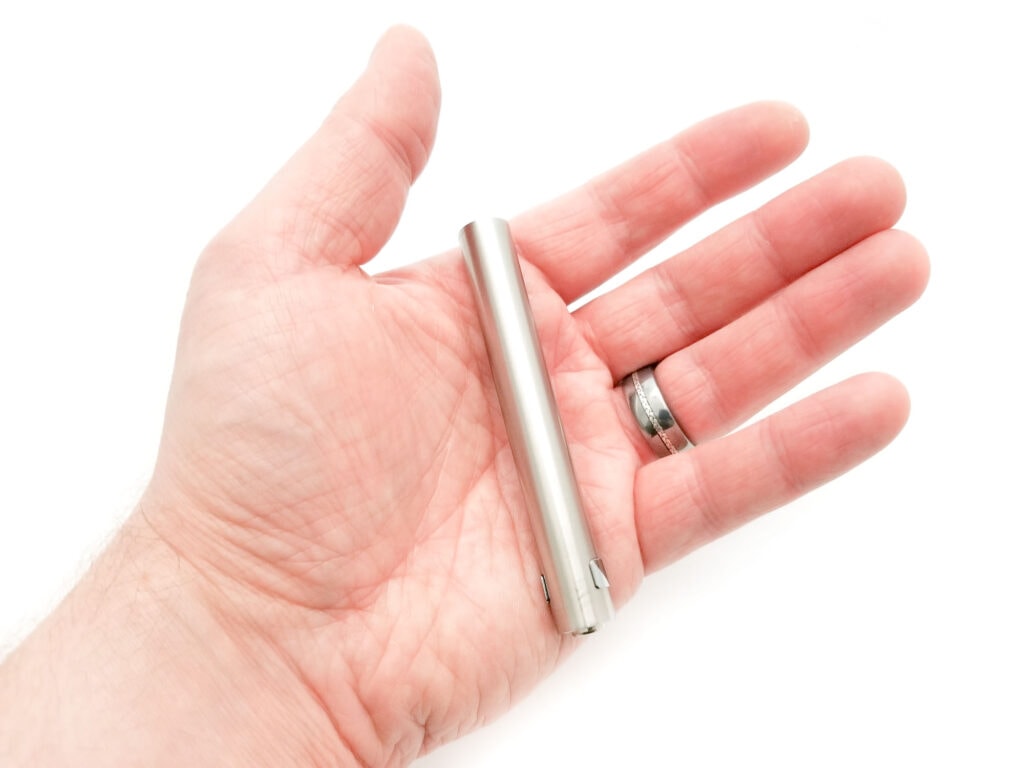
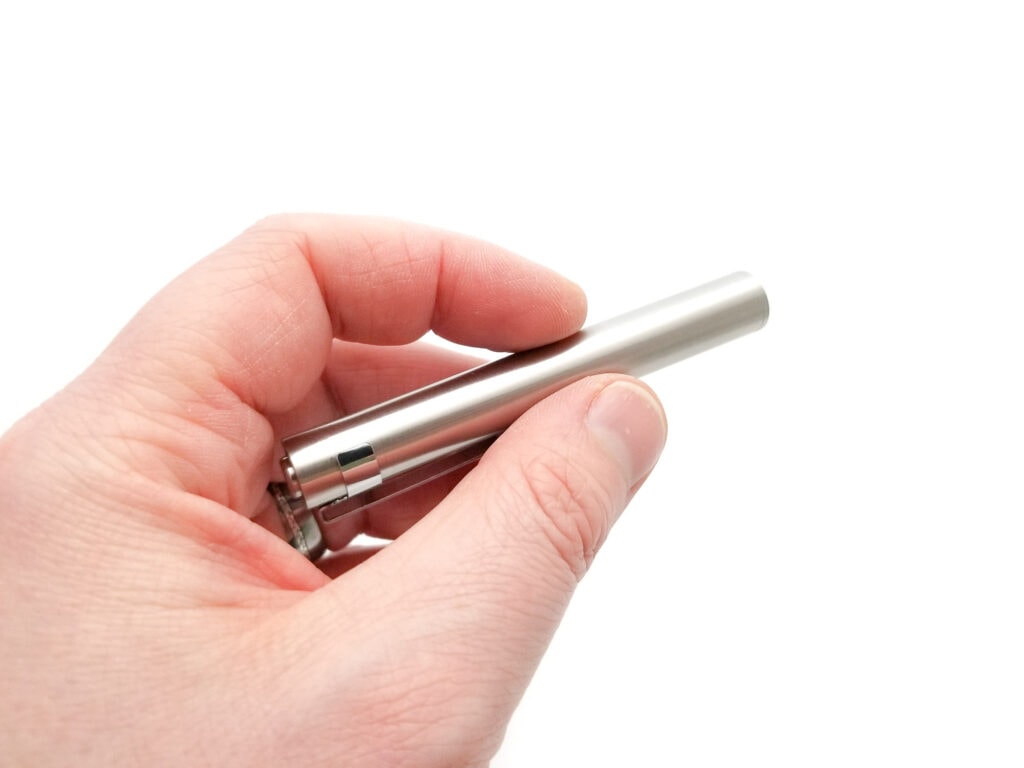
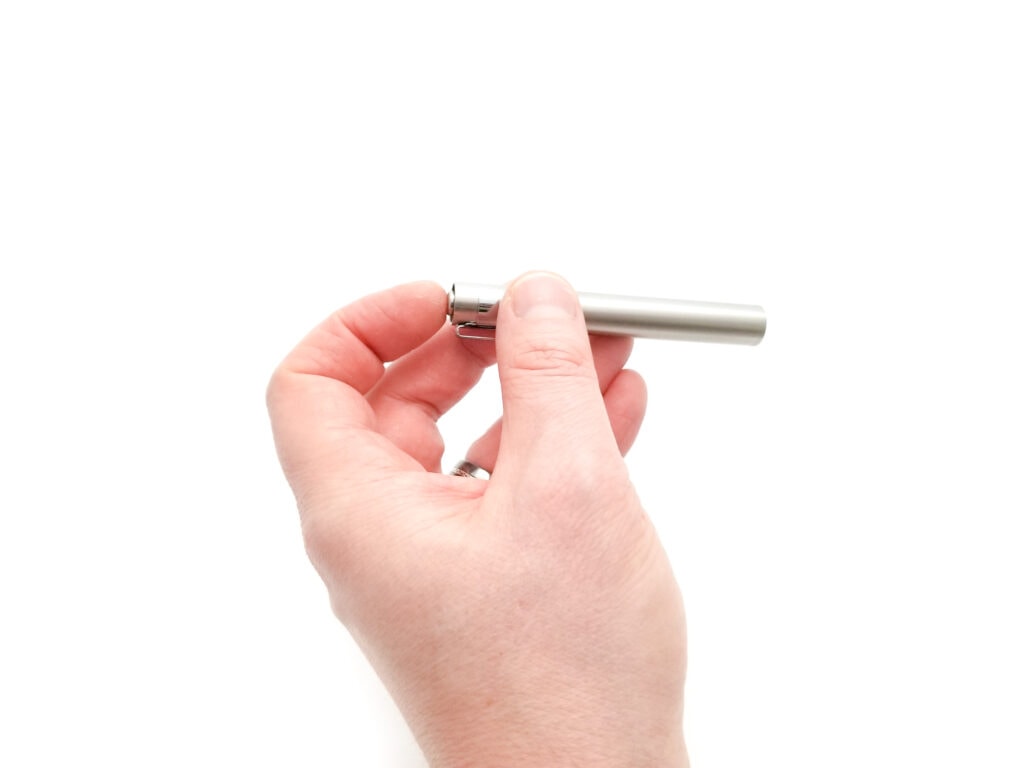
Build Quality and Warranty
The original group buy SingFire 348 could be had for around $6.99 in 2015, and that was part of the popularity, since factory lights with the good 219B were almost non-existent and expensive. 8 years on, the price swelled a bit, and the current 348 is for sale over at Killzone Flashlights for $14.99 US. Not a bad deal, but not a great deal either. The build quality is completely adequate here, and the only big concern was the LED wasn’t perfectly centered. What’s cool about it is the matched machining, done by chucking the assembled light in a lathe and running a finishing tool or some emery cloth over it until the gaps between the parts blend together.
The machining is adequate, and only the bezel had a visible seam. The bezel is removable, with the tailcap threads cut into the brass switch housing. Like the bezel threads, they’re triangular cut, exceedingly fine pitched, and very thin. They were smooth, but did require care to avoid cross threading them. The pocket clip puts sideways pressure on the tailcap, and that made getting the threads started difficult. It takes 6 rotations to fully seat the tailcap!
The bezel also unscrews to release the reflector, lens, an o-ring, a brass washer, a spring, and the tiny brass pill. There’s a roughly 12 mm long thin coil spring for the tailcap, and the driver also has a short, wiry gold plated spring. The soldering all around is done by hand and not too clean, but hey, out of sight, out of mind, right?
There’s a brass washer that goes between the driver that captures a spring for the ground connection to the flashlight body. Digging into this thing was like going back in time to pre-2013 flashlight design since it was put together a bit like the old SureFire P60 and some TrustFire lights. The LED wires are probably 26 AWG, which is fine since, and the tiny 10 mm MCPCB is aluminum and sits on top of the brass pill. The pill isn’t threaded or held in with a retaining ring. It just slides into the barrel and is captured by the tension from the driver and tailcap springs. For water resistance, tread lightly here since the only o-ring I saw was sealing the lens. Use our imagination for the IP rating.
For the warranty, it’s going to be vetted by Killzone Flashlights, so I pulled this from their website: On all Killzone Flashlights branded hog and predator lights we offer a 3-year warranty which includes the LED, light assembly and regular tailcap. We offer a 1-year warranty on all parts and light accessories such as batteries, chargers, mounts, wired tailcaps. Within three years of purchase we will repair or replace any Killzone Flashlights branded hog or predator light in the event it becomes damaged or defective no matter the cause—at no charge to you. If we cannot repair your product, we will replace it with a product in perfect working order of equal or better physical condition. After three years we will still repair any Killzone Flashlights branded item that can be repaired for a nominal fee of $20.00 to cover labor and return shipping excluding batteries since they cannot be repaired. We are not the manufacturer for any non “Killzone Flashlights” branded item and are not the provider of any manufacturer’s warranty service other than our line of flashlights, but we do serve as the middlemen for warranty service on many of the flashlight brands we carry. We will help you get a functioning light and will provide you with the best possible service we can during the warranty process. While we are not the manufacturer and are not responsible for the overall warranty service, we will help by troubleshooting the lights, consolidating and shipping the defective products back to each manufacturer at our expense, and then shipping the repaired or replaced lights back to you. Since most of the manufacturers are in China, the warranty process typically takes 1-3 months.

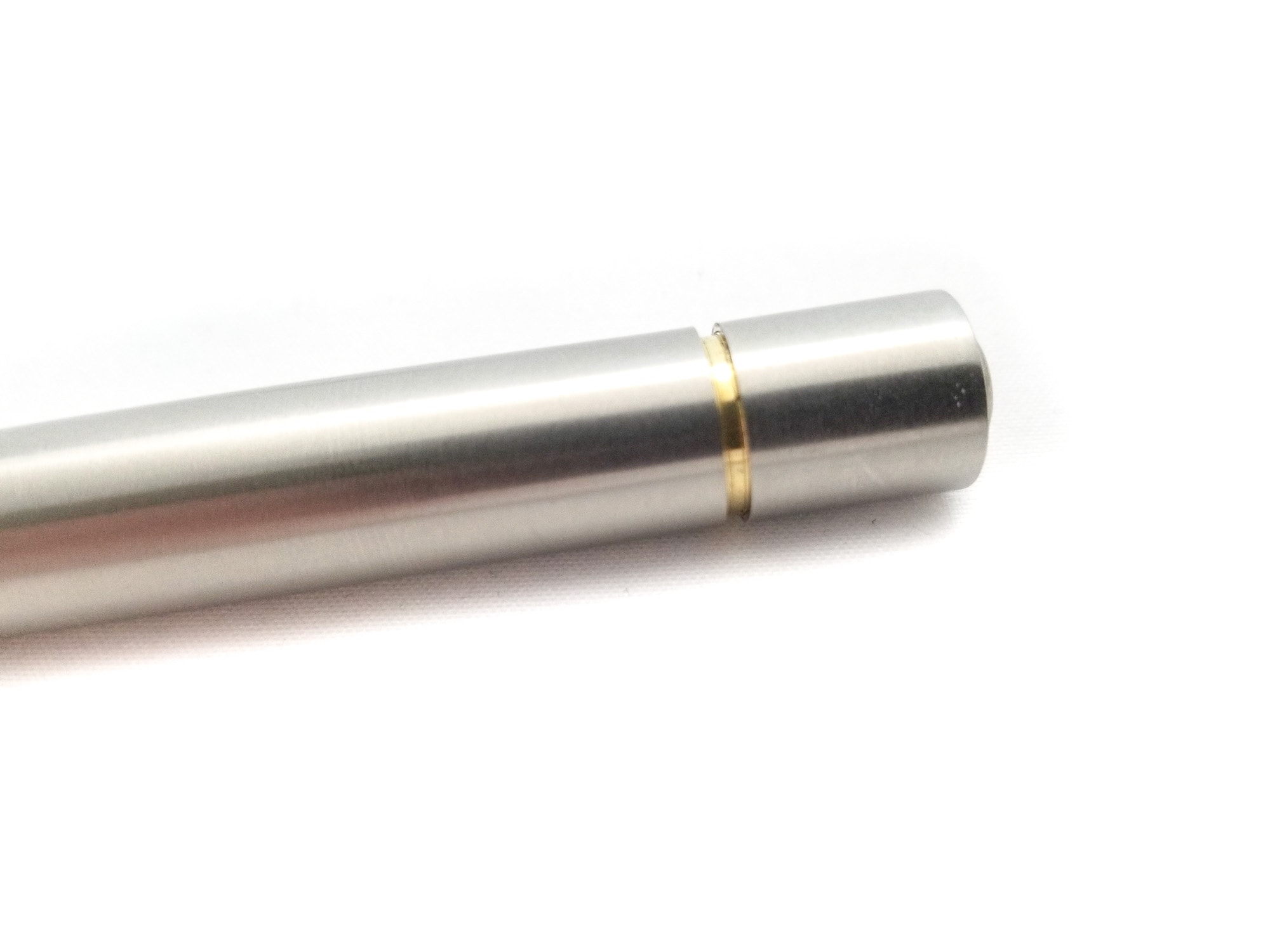
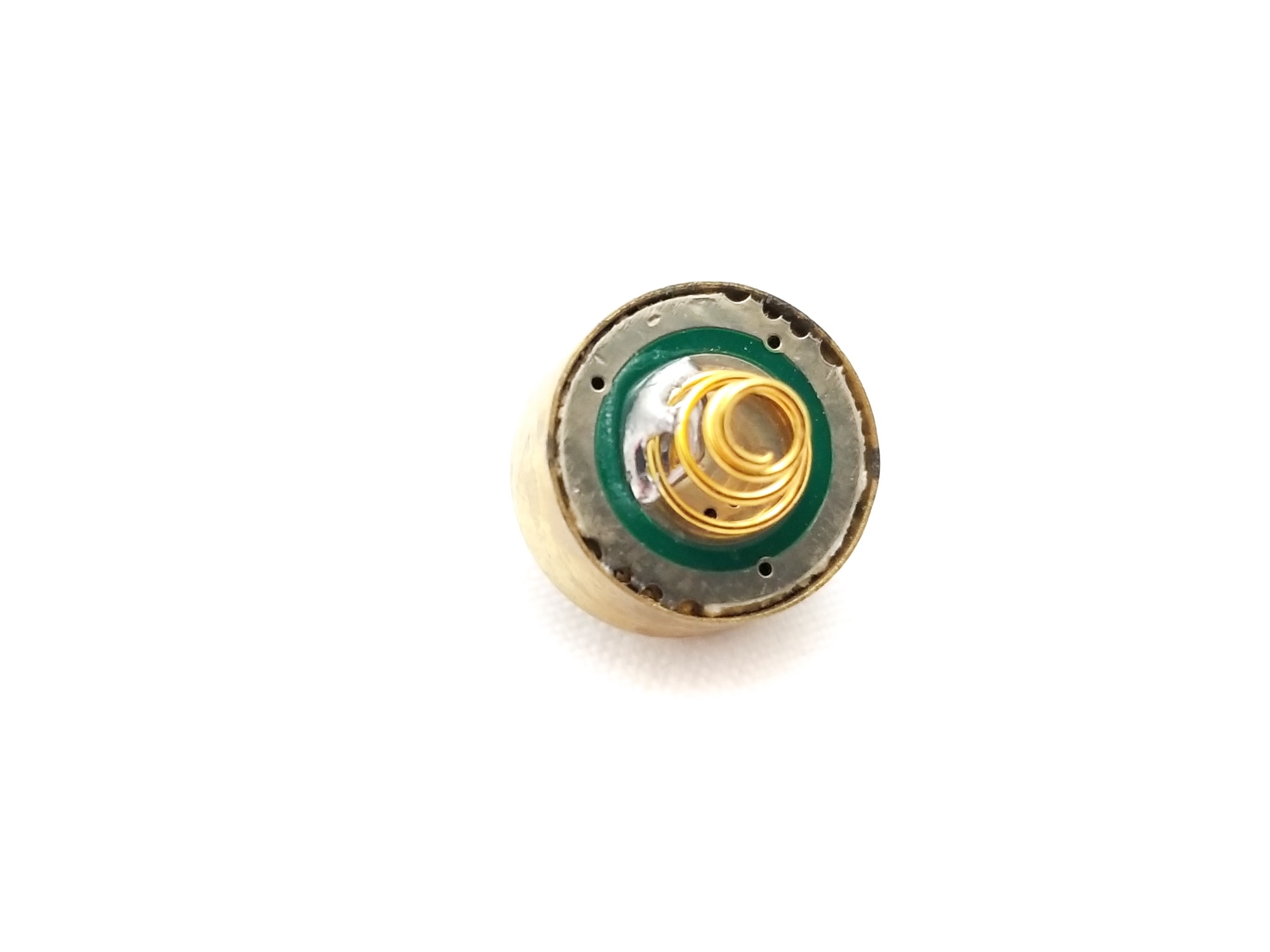
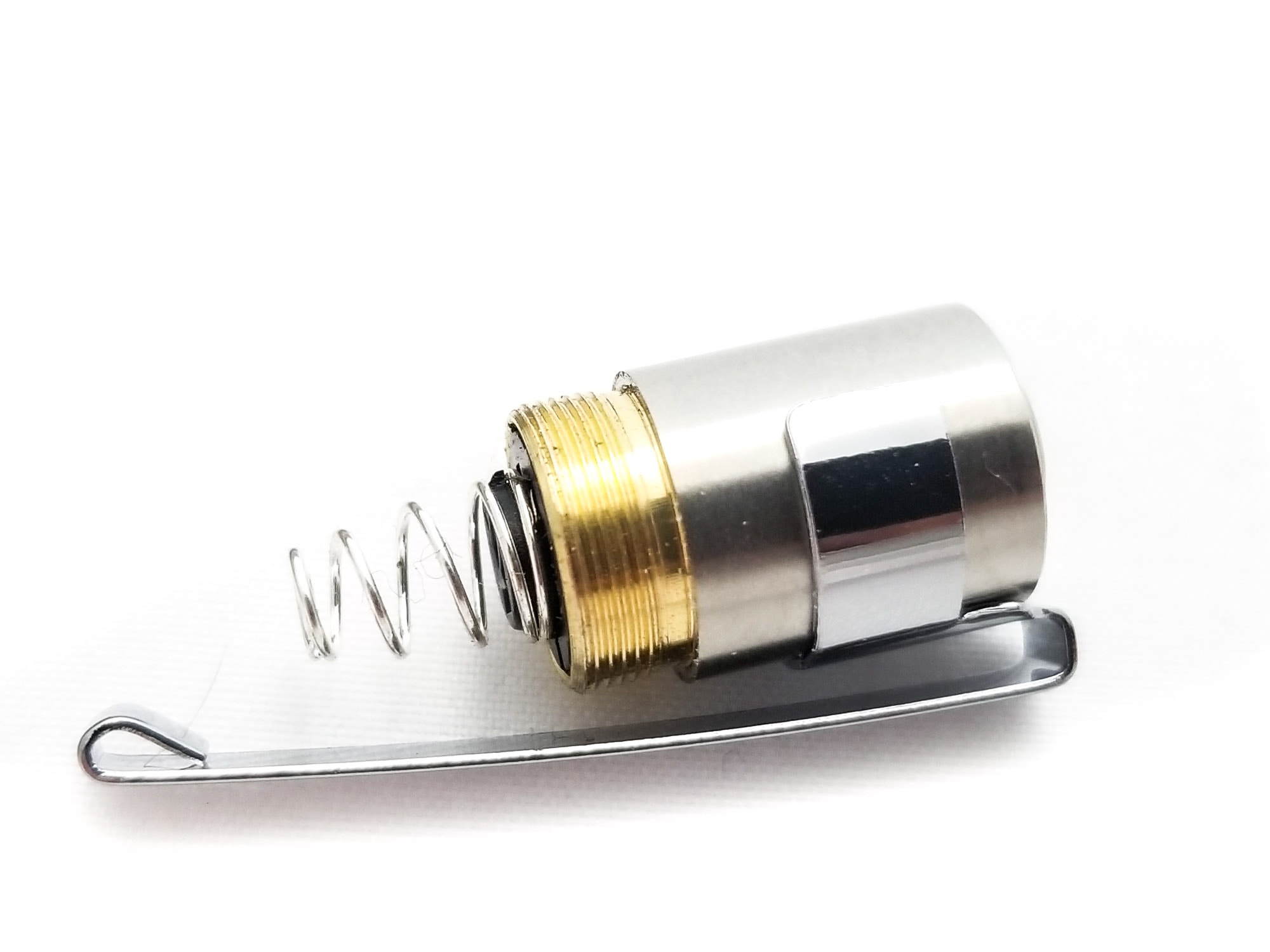
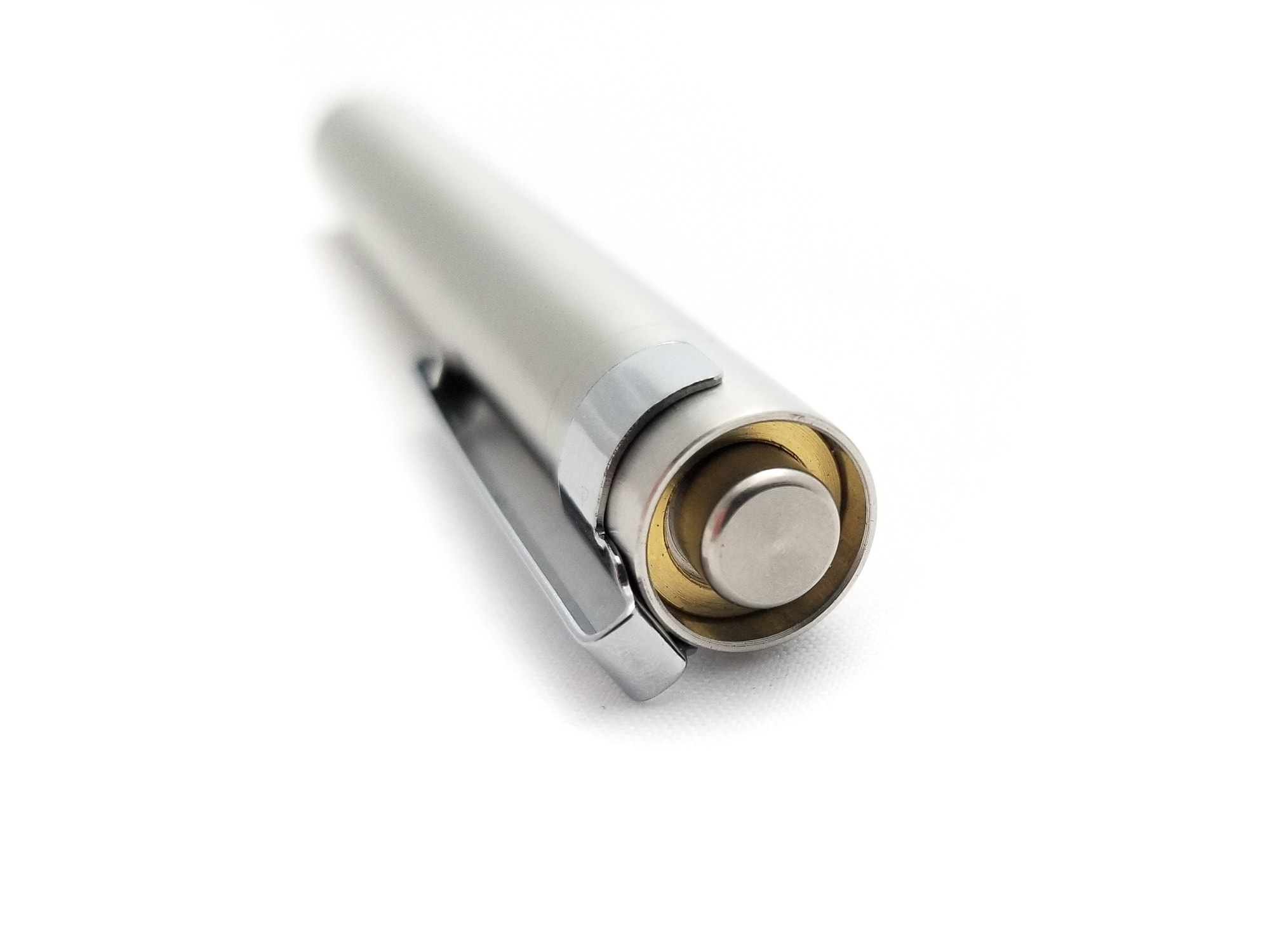
LED, Lens, Bezel, Beam, and Reflector
The centerpiece of the light is the LED and besides the low price, is what made it such a hit. It proves the theory that you can make an unremarkable flashlight interesting with a nice LED swap. The original SF-348 came with Cree XP-E or XP-G LEDs in cool blue, low CRI.
The BLF edition SF-348 came with the most sought-after high CRI LED to grace the flashlight continuum, the Nichia 219B NVSW219B-V1 sw50 R9050 in 5000K. When Killzone started selling these in 2018, they could be had with the warmer SW45K R9080 (4500K) variety, and later models with the 219C, still in R9080 and 4500K. The Killzone 2022 version features the Nichia 519A SM455 M500 L5 R9080. This is a 95+ CRI 4500K LED and it’s been featured in a ton of enthusiast lights these days and for good reason. It can handle much higher drive currents than the 219B and 219C for higher output, but maintain the amazingly nice color reproduction and tint of the 219 series. It’s still a 3535 size CSP type LED (no bond wires) with a homogenous LES. It’s less floody than the competitor Samsung LH351D, and has better tint.
The reflector is a teeny-tiny OP unit about 8.75 mm wide and it’s fairly shallow with no centering gasket, but it does have an insulator to keep it off the MCPCB. Hey, there’s a glass lens! I was surprised to see that, and although it’s not AR coated, it doesn’t really need to be. There’s a single o-ring between the lens and reflector and bezel, which is basically a stainless ring that threads into the barrel. The lens is recessed quite a bit, about 3.5 mm so it’s well protected.
The beam is a nice EDC type beam with a huge area of diffuse spill with what amounts to a huge hotspot with diffuse spill. It has very little distance, but adequate for a small penlight. The really nice thing is the beam quality. In short, it’s really, really, really nice. At 2 meters from the sensor using a 10440 battery, the Opple Lightmaster Pro has the tint coming in at 4613K with an CRI Ra of 98.2. The duv is -0.0053. Color reproduction is excellent, and it’s an exceedingly pleasant and welcoming rosy tint.
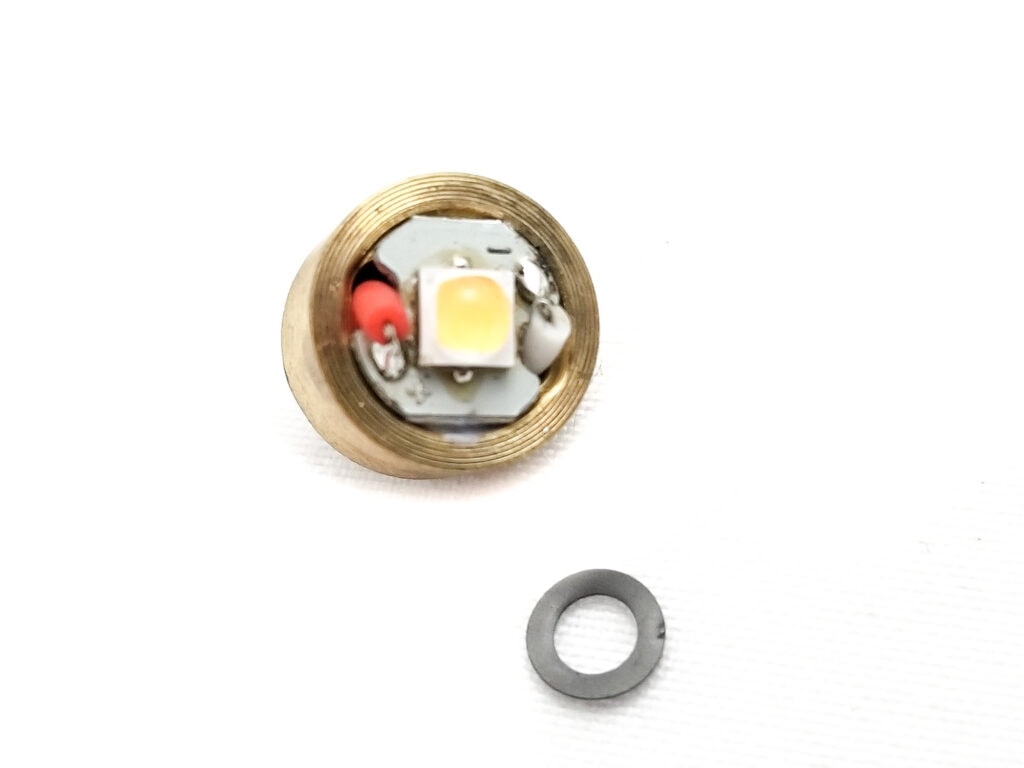
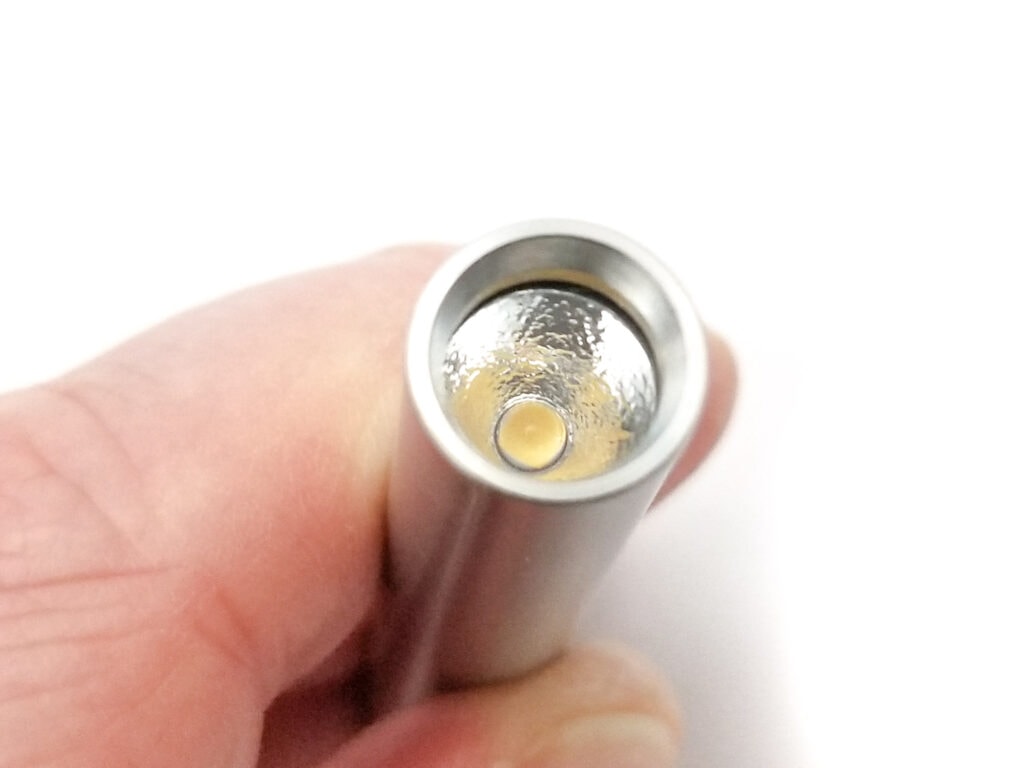
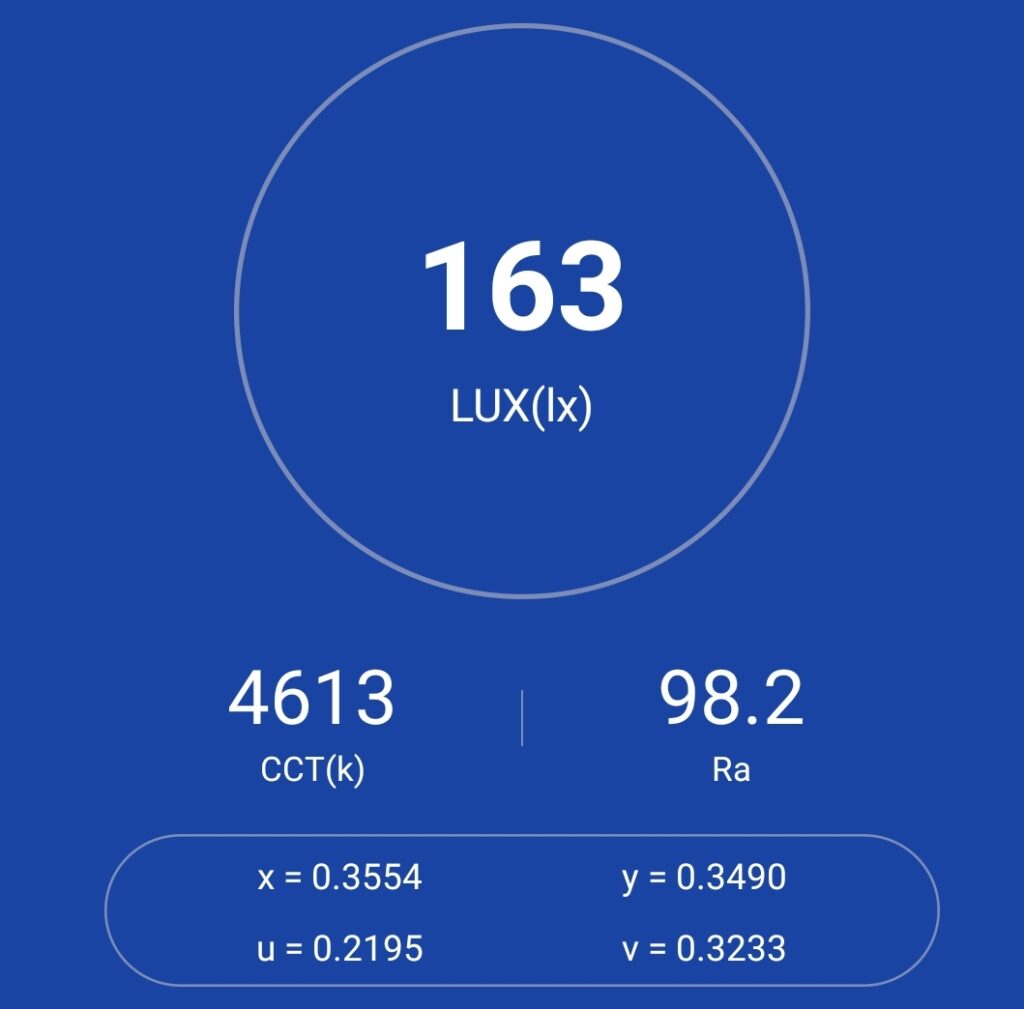
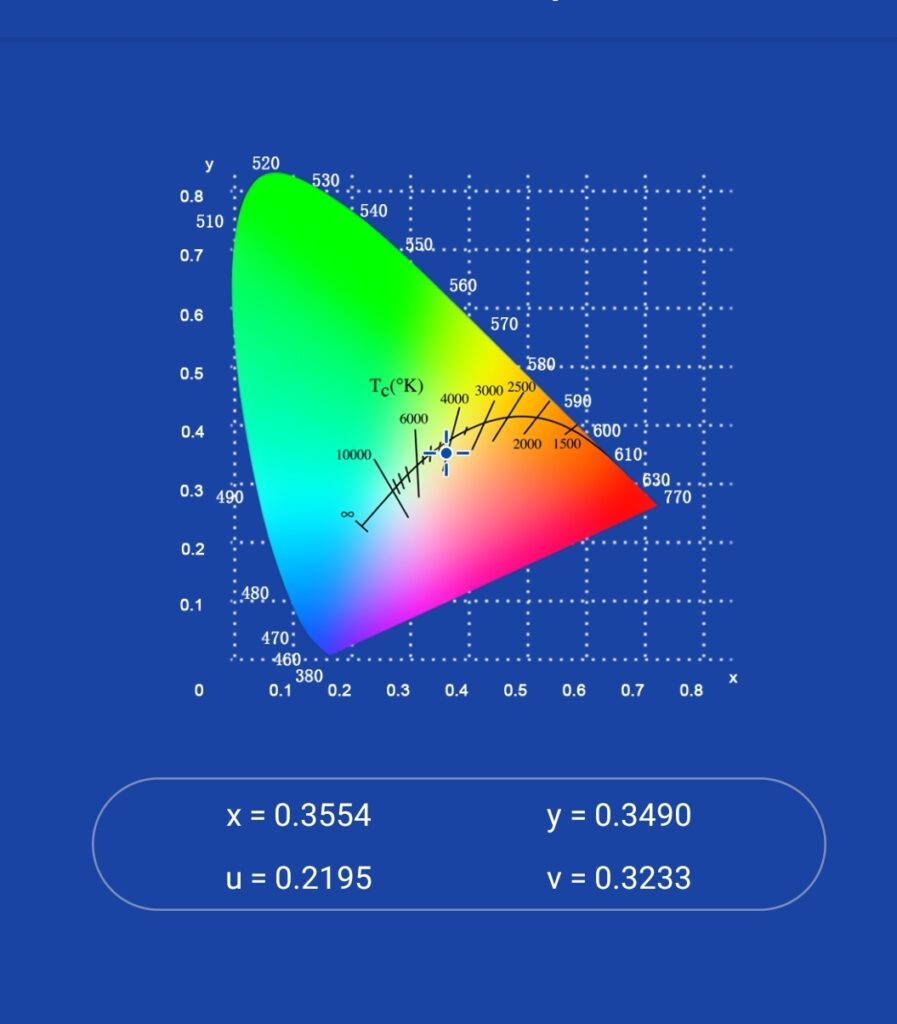
Dimensions and its competition
Dimensions:
| Millimeters | Inches | |
|---|---|---|
| Length | 89 mm | 3.5 in |
| Diameter | 12 mm | 0.5 in |
Dimensions are rounded to the nearest millimeter, and to the nearest tenth of an Inch.
Weight:
| Weight in grams | Weight in oz | |
|---|---|---|
| Without battery: | 26 g | 1 oz |
| With VapCell 320 mAh 10440 | 35 g | 1 oz |
| With Alkaline AAA | 38 g | 1 oz |
| With Ikea LADDA 900 mAh NiMH | 38 g | 1 oz |
Weight is rounded to the nearest gram, and to the nearest tenth of an Oz.
Flashlight size comparison with its competition:
Group 1 top to bottom: Streamlight Keymate, BLF348, Olight i3T EOS, Thorfire PF01
Group 2 left to right: Thorfire TG06, Sunwayman R10A, BLF348
Group 3 top to bottom: Sofirn SP10 v3, Lumintop FWAA, BLF348, Fenix E09R
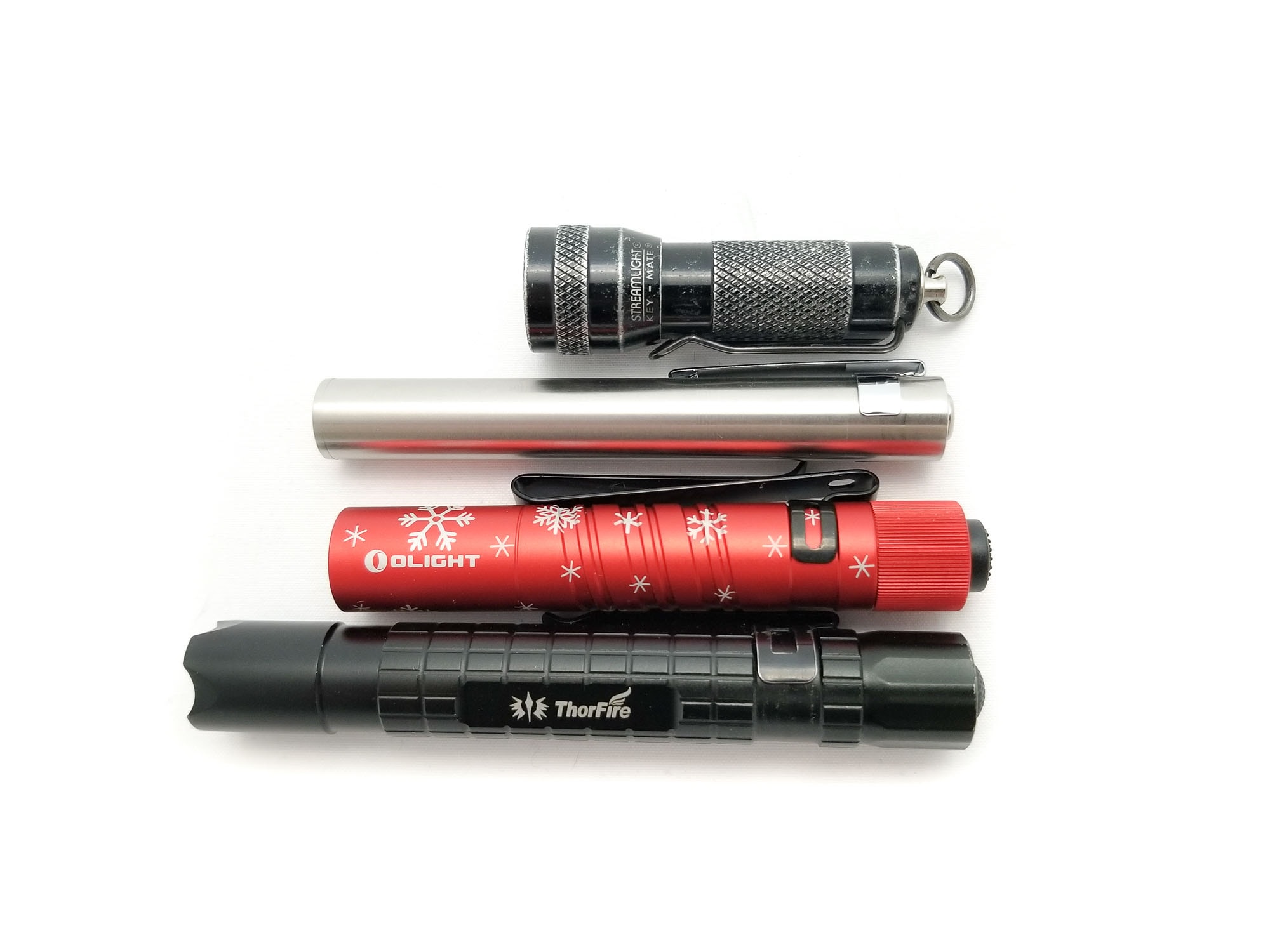
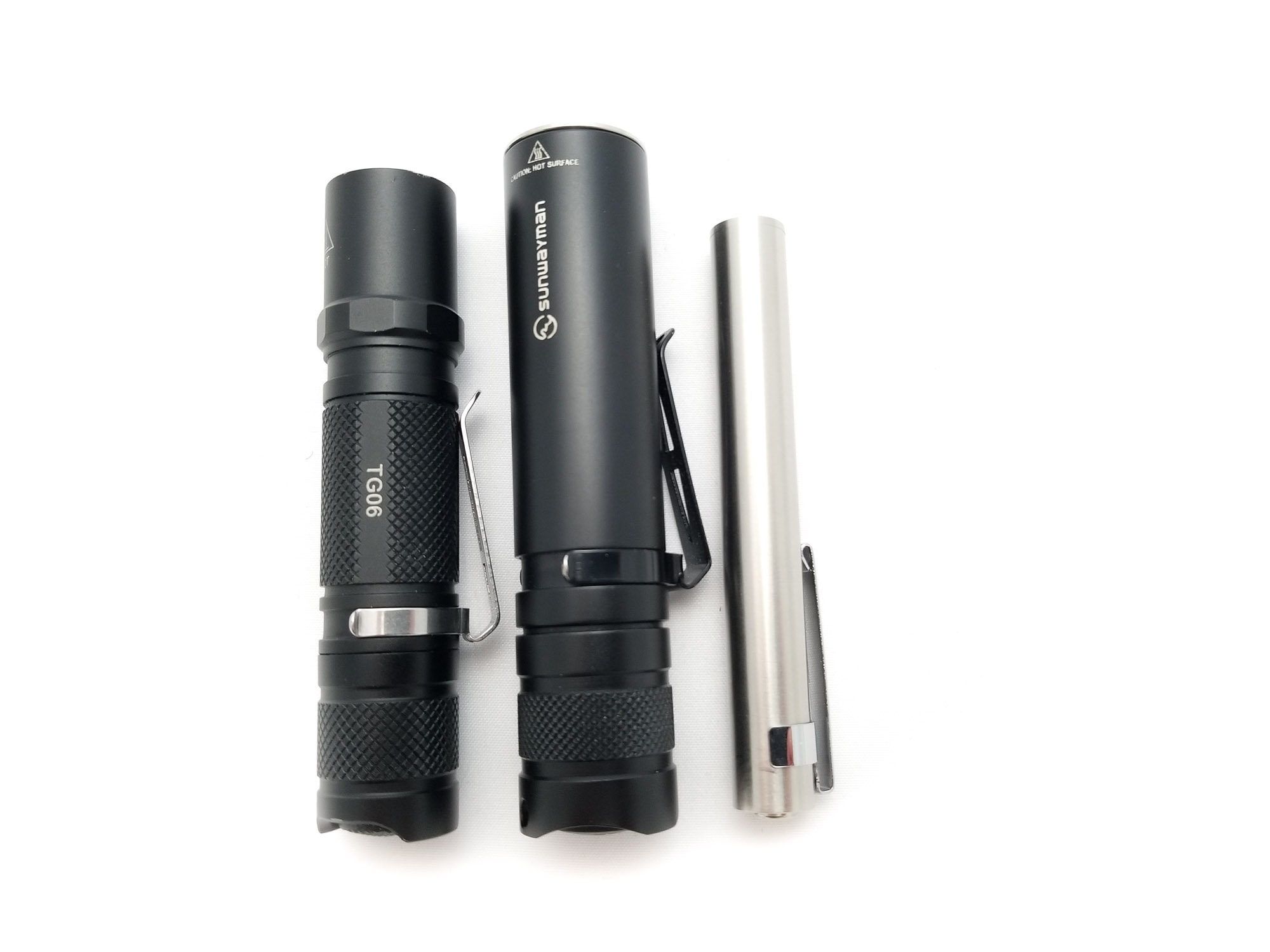
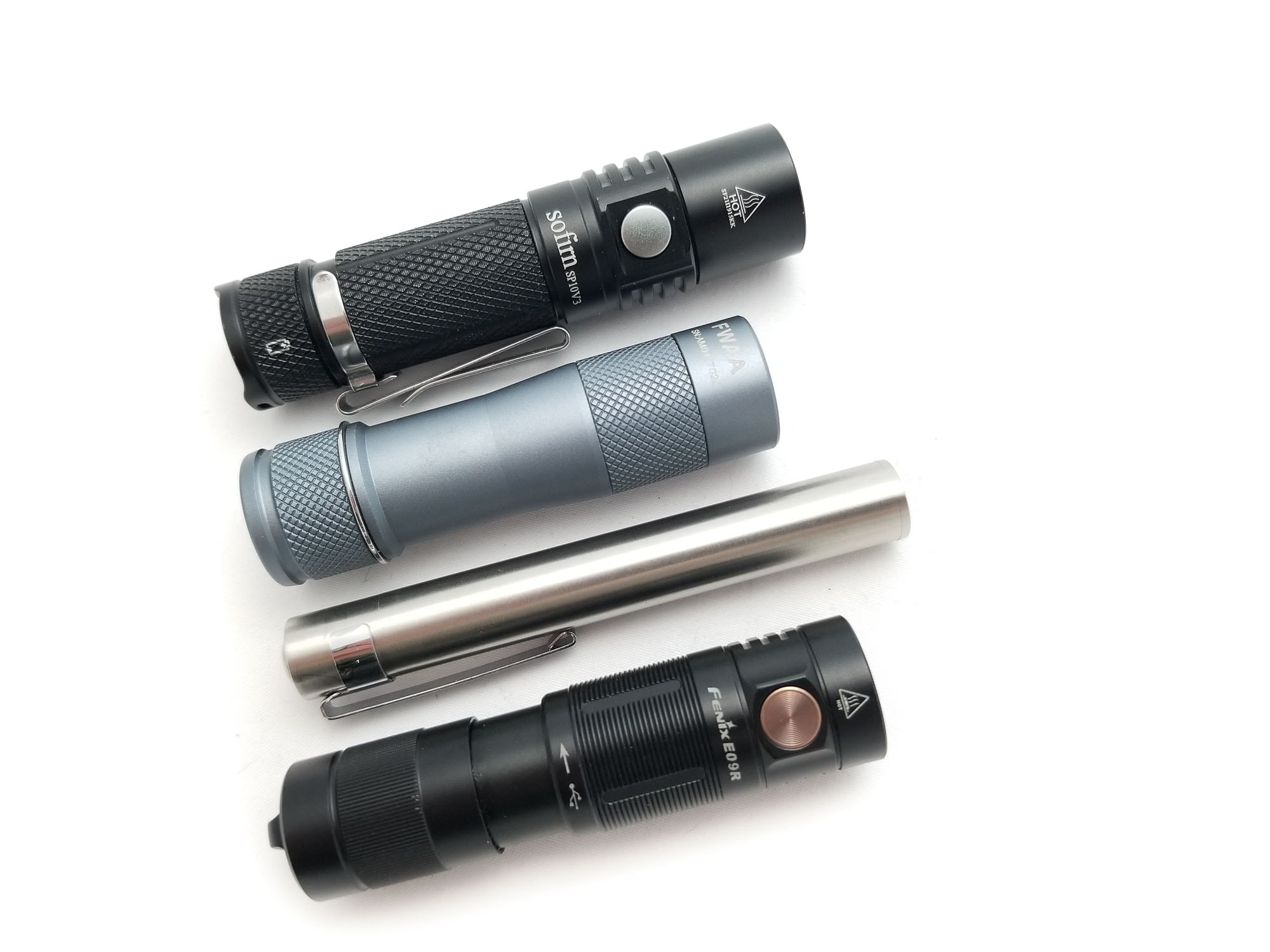
Killzone BLF348 UI: User Interface and Driver
Since this is a multi-chemistry flashlight and can run any AAA out there, it needs a boost driver to bump the voltage to run the 519A. Since it can run li-ion 10440 batteries, the driver has a pass-through channel that basically turns direct drive when used with the 4.2 volt batteries. This could be problematic since there’s nothing to regulate the output other than the internal resistance of the LED, wires, springs, battery, etc. It will be interesting to see if LVP saves the li-ion or drains it dangerously low.
The UI is as simple as it gets. Even Gomer Pyles couldn’t mess it up. Click it on. Click it off and that’s it.
Available modes:
- Just one. On or off.
Available blinky modes:
- None
From OFF:
- Fully click the switch: Turns on
From ON:
- Half-press the switch: Momentary off
- Fully press the switch: Turns off
Mode memory:
- None
Shortcuts:
- None
Low voltage warning:
- None, except the LED gets very dim as the battery drains.
Strobe/blinkies
- None, but you can half-press the switch really fast for manual strobe.
Lock-out mode:
- None
PWM
- None visible
Additional/summary info on the UI:
- After sampling a ton of flashlight UIs, believe me when I say it’s refreshing to get one that doesn’t need an instruction manual. There’s no learning curve here, no mode memory, no double or triple clicks either, and no configuring. Just one click on, one click off and that’s it. While the functionality is limited and you’re giving up moon or low mode, it’s still fine for the intended purpose. LVP is basically non-existent. Your NiMH will probably discharge to under 1 volt, and Alkalines don’t care if you drain ‘em deader than Jimmy Hoffa.
- However, your li-ions will need to be monitored to keep them from being too deeply discharged because this will keep running until there’s too little energy in the battery to keep the LED lit (ask me how I know that). There’s no thermal limiting either, so on direct drive with the li-ion it’s going to get mighty toasty (spoiler alert, it does).
Killzone BLF348 Charging and batteries
This is an AAA flashlight, and like the original BLF-348, it can take all types and voltages of AAAs, from Alkaline to li-ion 10440 and everything in between. This makes it extremely handy and versatile, since you’ll never be left without power sources. I tried some VapCell 320 mAh 3 A 10440s, a Harbor Freight house brand Alkaline AAA, and a 900 mAh Ikea Ladda NiMH. The flat top 10440s fit fine, as did button tops. The cells also fit in the tube without too much rattling. There’s no onboard charging, so your NiMH and li-ions need their own charger. If you’re only running this on Alkalines, be careful to take them out if not using the light for a long time since they will leak and destroy the inside of the light. I recommend using li-ions, 1.5 volt AAA lithium primary cells, or NiMH in the light to keep it living a long time.
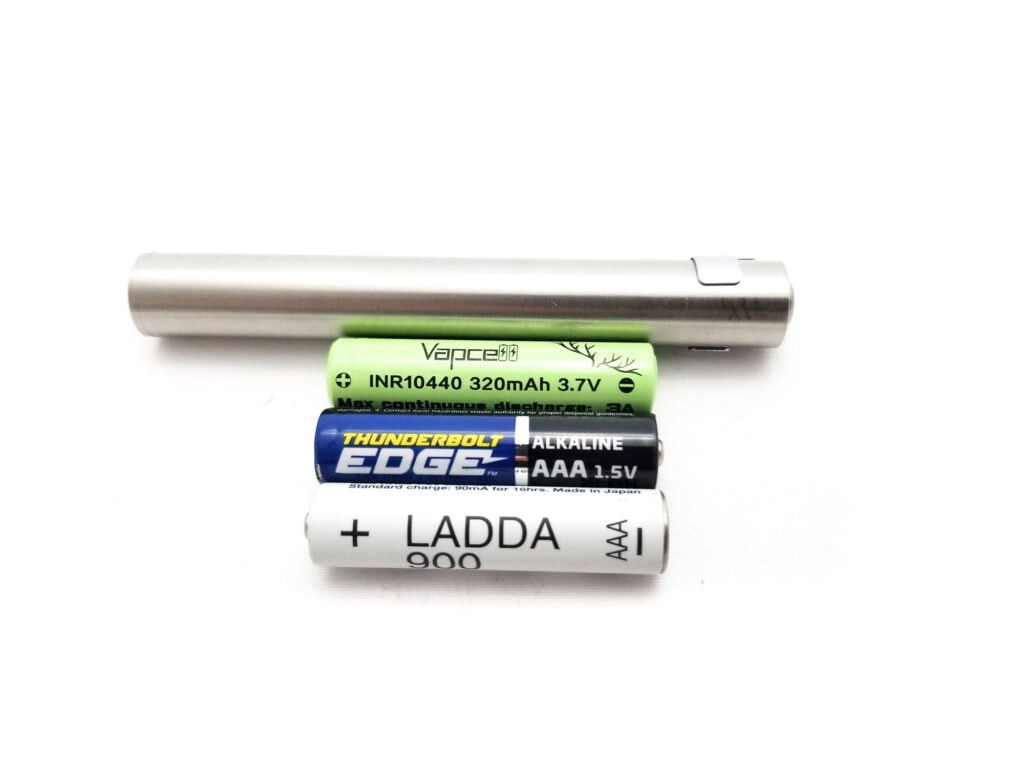
Performance test
Lumen measurements (for each mode)
Lumens are measured in my 50 cm integrating sphere with a Digi-Sense 20250-00 data logging luxmeter. The sphere has been calibrated with a Convoy S2+ measured to 260 Lumens and the figures are within 10% of actual. Current was measured with my Thisinde 18B+ multimeter with 14 gauge wires in the meter. I tested the output with an Ikea Ladda 900 mAh NiMH, a fresh one-hung-lo brand Alkaline, and a VapCell 320 mAh 10440 li-ion.
| Mode | Amps at start | Specs | turn on | 30 sec | 10 minutes |
|---|---|---|---|---|---|
| 10440 li-ion | 1.41 A | 175 | 211 lm | 187 lm | 125 lm |
| Alkaline | 650 mA | ? | 38 lm | 34 lm | 33 lm |
| NiMH | 430 mA | 50 | 38 lm | 34 lm | 33 lm |
Parasitic drain:
- It’s a mechanical clicky switch
I totally crushed the advertised output on the li-ion 10440, but am coming in a bit low for the 1.5 volt batteries. The Ladda is a pretty decent cell, so I was a bit surprised to see the output lower than advertised. The fact the cheap Alkaline is drawing more current probably is due to its slightly higher open circuit voltage.
Battery Life: Runtime graphs
Lumens are measured in my 50 cm integrating sphere with a Digi-Sense 20250-00 data logging luxmeter. The sphere has been calibrated with a Convoy S2+ measured to 260 Lumens and the figures are within 10% of actual. I ran the single mode with three batteries: The VapCell 320 mAh 10440, AAA Alkaline, and the NiMH.
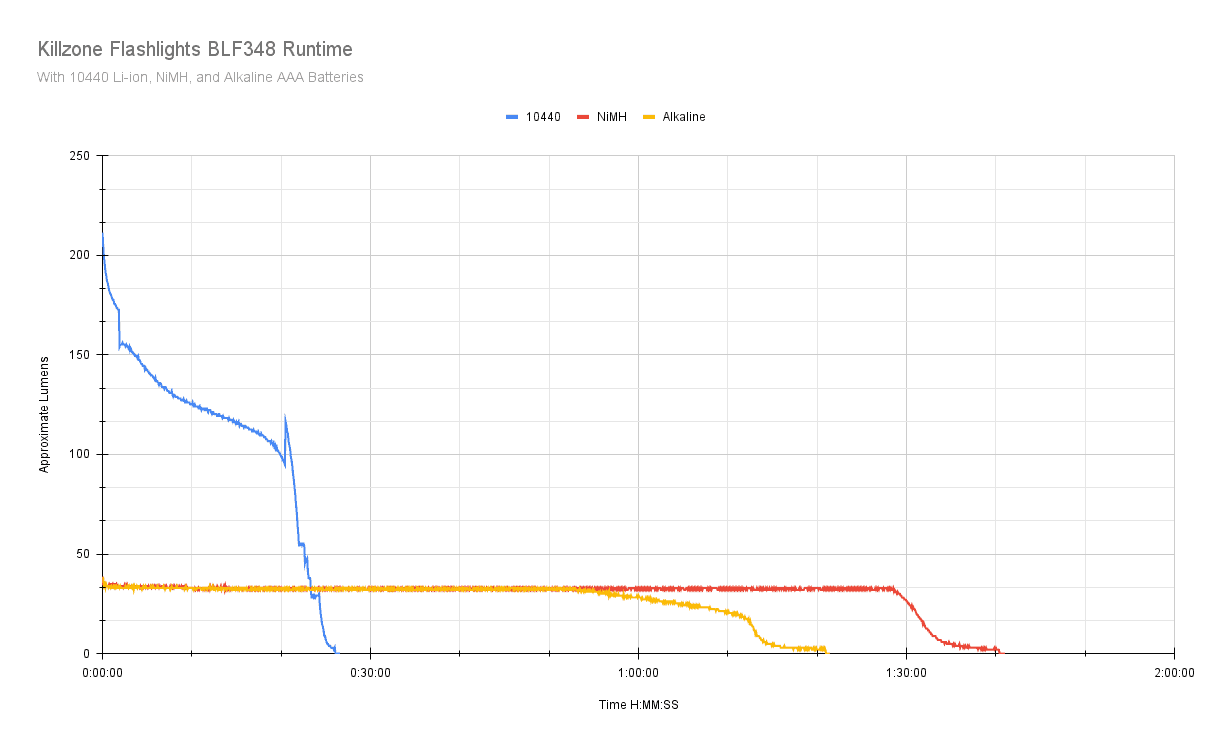
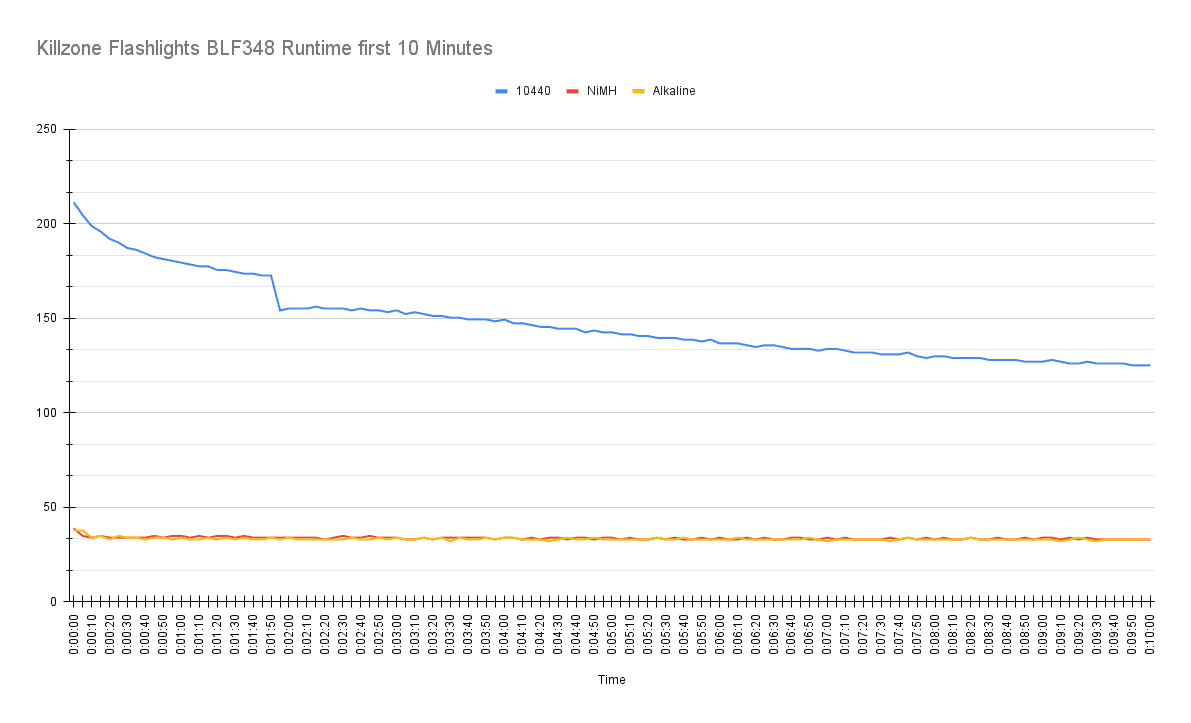
| Mode | Specified | Measured runtime ANSI | Time till shut off |
|---|---|---|---|
| 10440 li-ion | ? | ? | 26m |
| Alkaline | ? | ? | 1h 20m |
| NiMH | ? | ? | 1h 40m |
The runtimes were pretty predictable, with the 10440 giving the best output, but only a piddly 26 minutes of runtime. The NiMH is the best bet for duration, with the Alkaline giving about 20 minutes less output. The runtimes are nice and flat for the 1.5 volt batteries because there’s a boost driver at work here, so the current and voltage are both constant until the boost IC drops out of regulation.
Since the 10440 is direct drive, it behaves as such and the output drops with the battery voltage. Besides the brief runtime, the consequence of the higher output for the 10440 was heat. There’s no thermal regulation here, and about the 8 minute mark I got a bit worried since my infrared temp gun said 101 C (That’s over 200 F). It didn’t heat up as fast as I thought it would, by 120 seconds I saw 60 C, but by the 15 minute mark it had cooled off a bit. It was still hand holdable the entire runtime though due to the poor thermal conductivity of stainless steel, and the heat was centered in a roughly ⅞ inch section of the head, away from where fingers would be.
On the other batteries, it was more tame, never reaching 50 C. There’s no LVP, and while it’s not a big deal for a NiMH or Alkaline battery, it is for a 10440, which shouldn’t be discharged below 2.6 volts. Well, apparently, this thing didn’t get the memo, and after the test, the 10440 was at 0.84 volts. The NiMH was 1.1 volts, and the Alkaline was 0.98 volts. If you must run the Killzone Flashlights BLF348 with the 10440, do what I say and not what I do and don’t run it until it gets really dim (or until it shuts off).
About ANSI FL1 standards: The runtime is measured until the light drops to 10% of its initial output (30 seconds after turning on). This does not mean that the flashlight is not usable anymore. The last column shows how long the light actually works till it shuts off. If there is a + symbol, it means that the test was stopped at that particular point, but the light was actually still running. This happens on certain occasions, with certain drivers, firmware, or batteries.
Peak beam intensity and beam distance measurements
Beam distances are measured using a Uni-T UT383S luxmeter measured indoors at 5 meters using the three battery types. Measurements taken at 30 seconds.
| Mode | Specified | Candela measured | Meters | Yards |
|---|---|---|---|---|
| 10440 li-ion | ? | 825 cd | 57 | 63 |
| Alkaline | ? | 175 cd | 26 | 29 |
| NiMH | ? | 175 cd | 26 | 28 |
Killzone doesn’t list throw specs for the 348, but it’s about what I expected from a tiny OP reflector and a domed LED. On the 10440 I got 1000 cd and 63 meters on start, so not too bad. Even at ANSI FL1, on the 10440, 57 meters is good enough for most household stuff.
About peak beam intensity: Peak beam distance according to ANSI FL1 standards: The calculated value of distance in meters at which the flashlight produces a light intensity of 0.25 lux. (0.25 lux is about the brightness of a full moon shining on an object). The columns ‘Meters’ and ‘Yards’ use rounded numbers.
Beamshots
I compared the BLF348 to some other AAA, AA, and tiny flashlights. Photos taken with my Samsung Note 8. The indoor shots are with the camera set to 1/15s ISO 100 and 5000K WB.
Beamshots of the following flashlights compared:
- BLF 348
- Olight i3T EOS
- Thorfire PF01
- Skilhunt M200
- Fenix e-Lite
- Fenix E09R
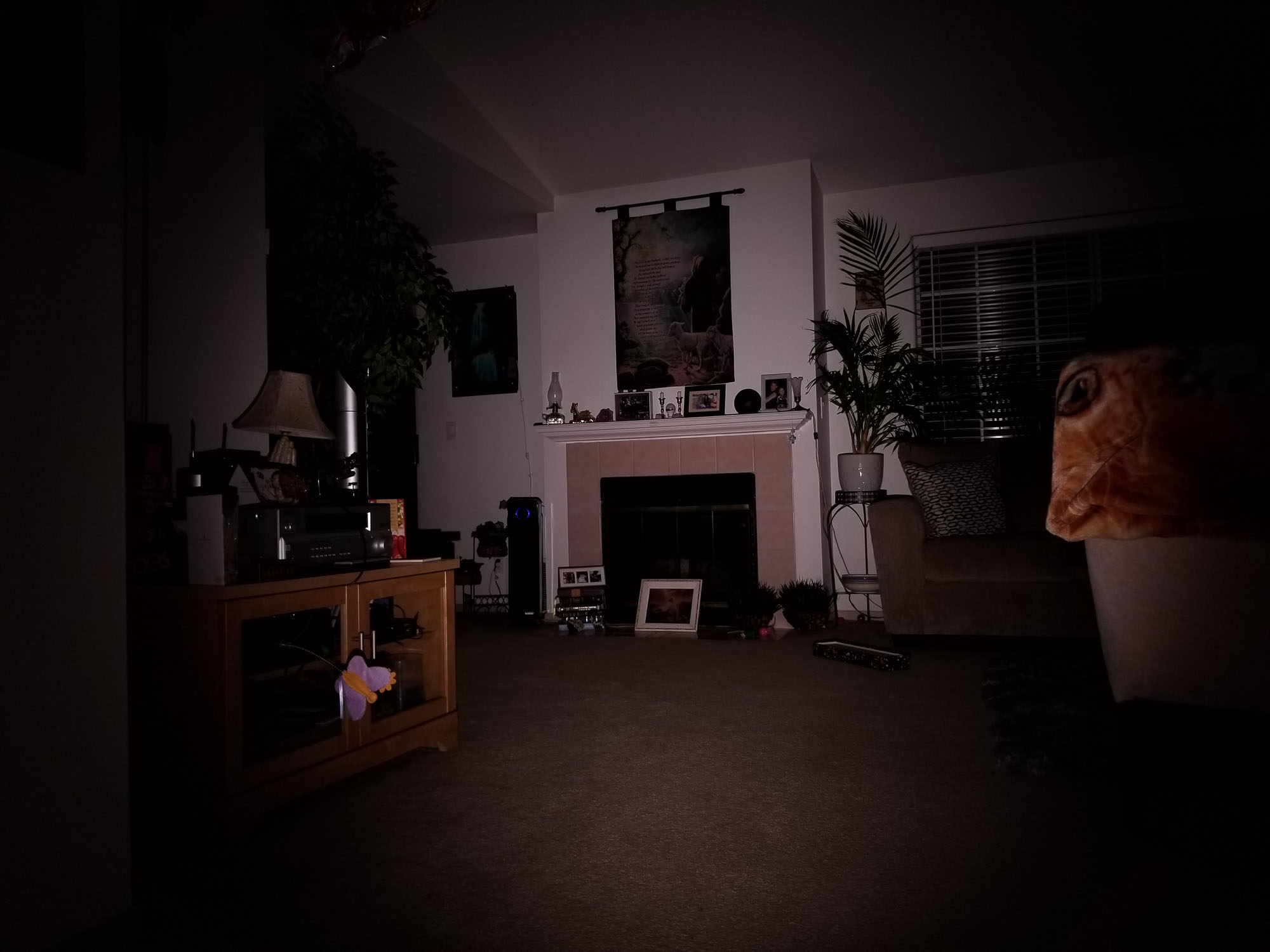
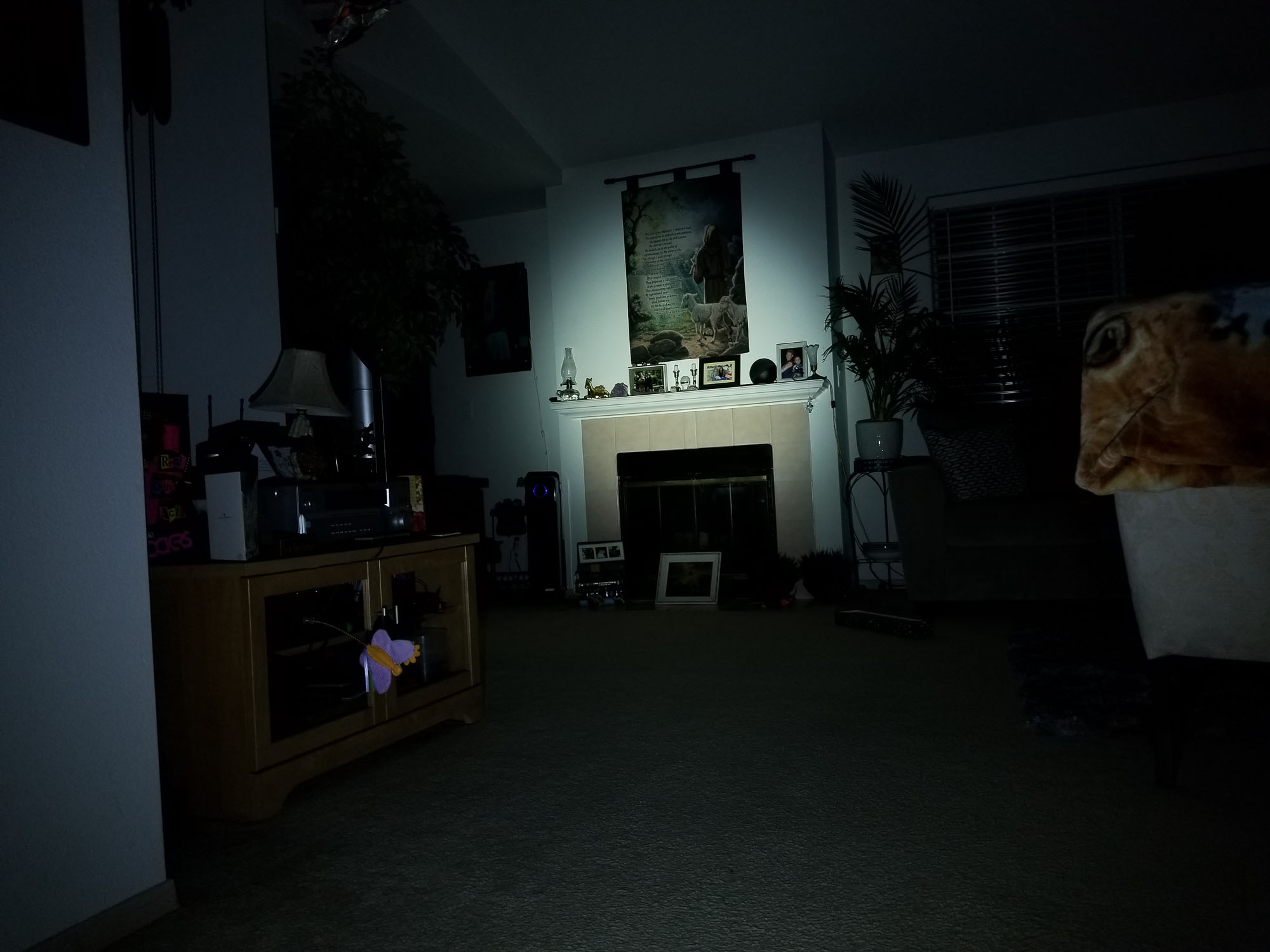
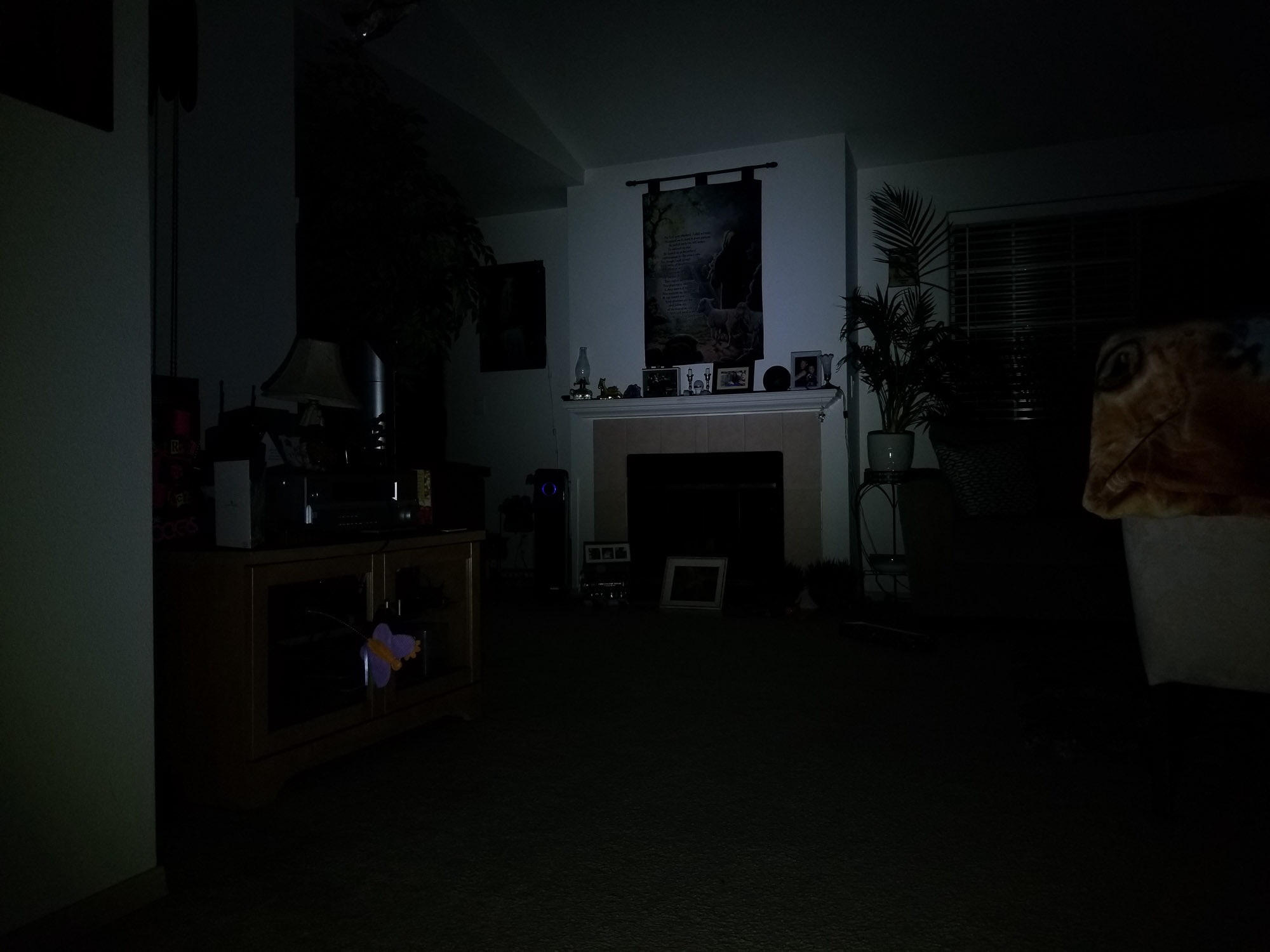
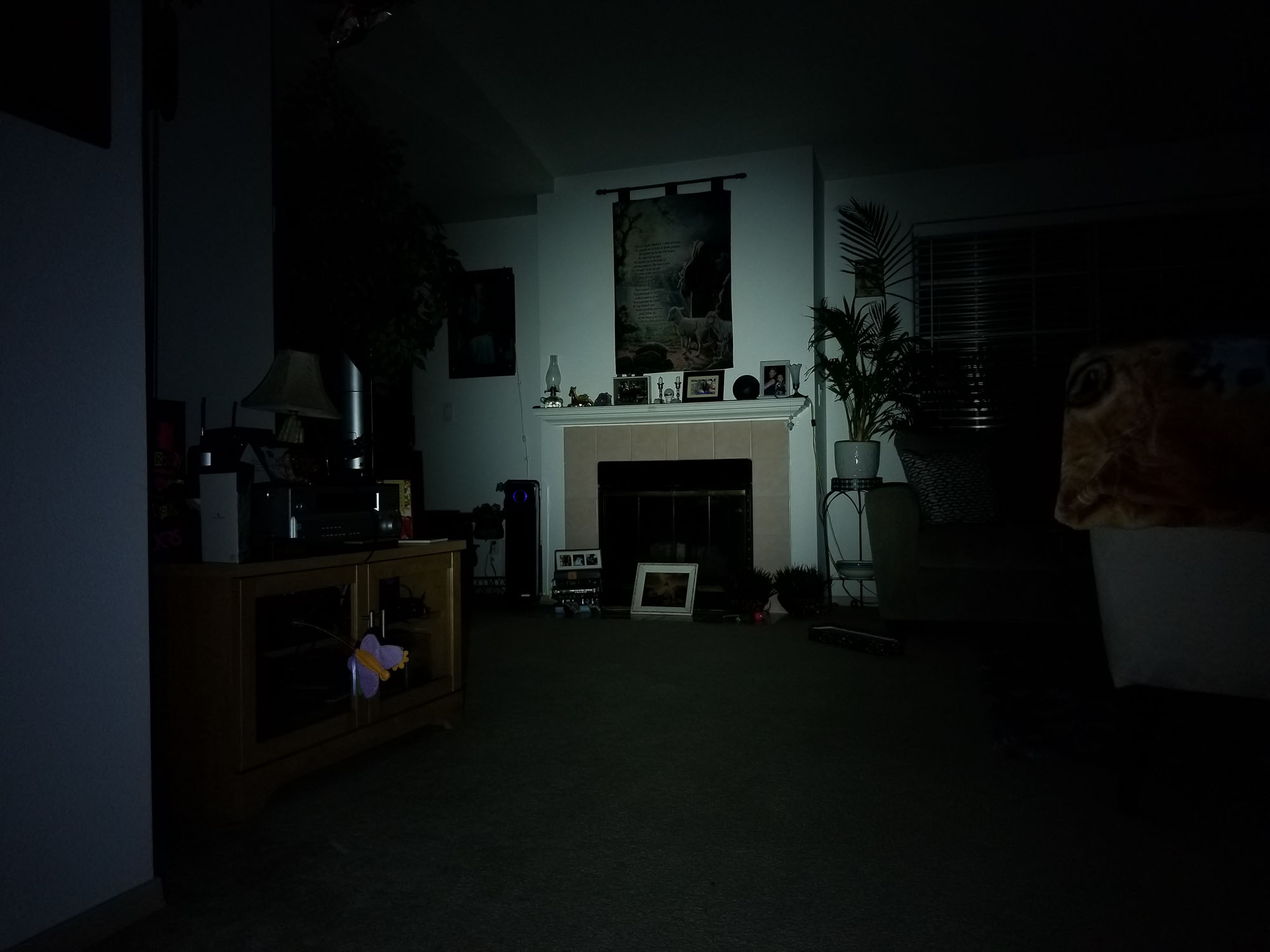
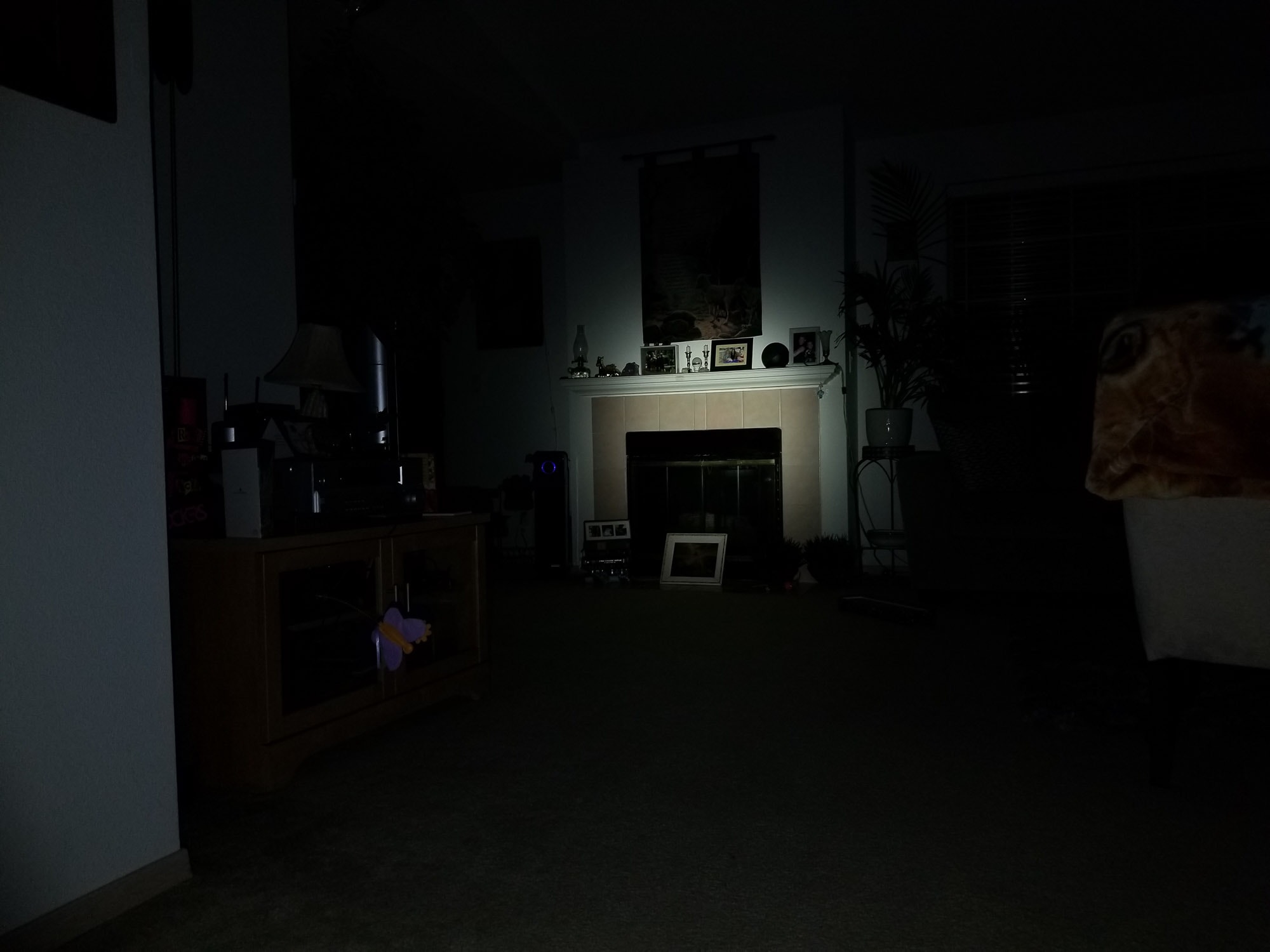
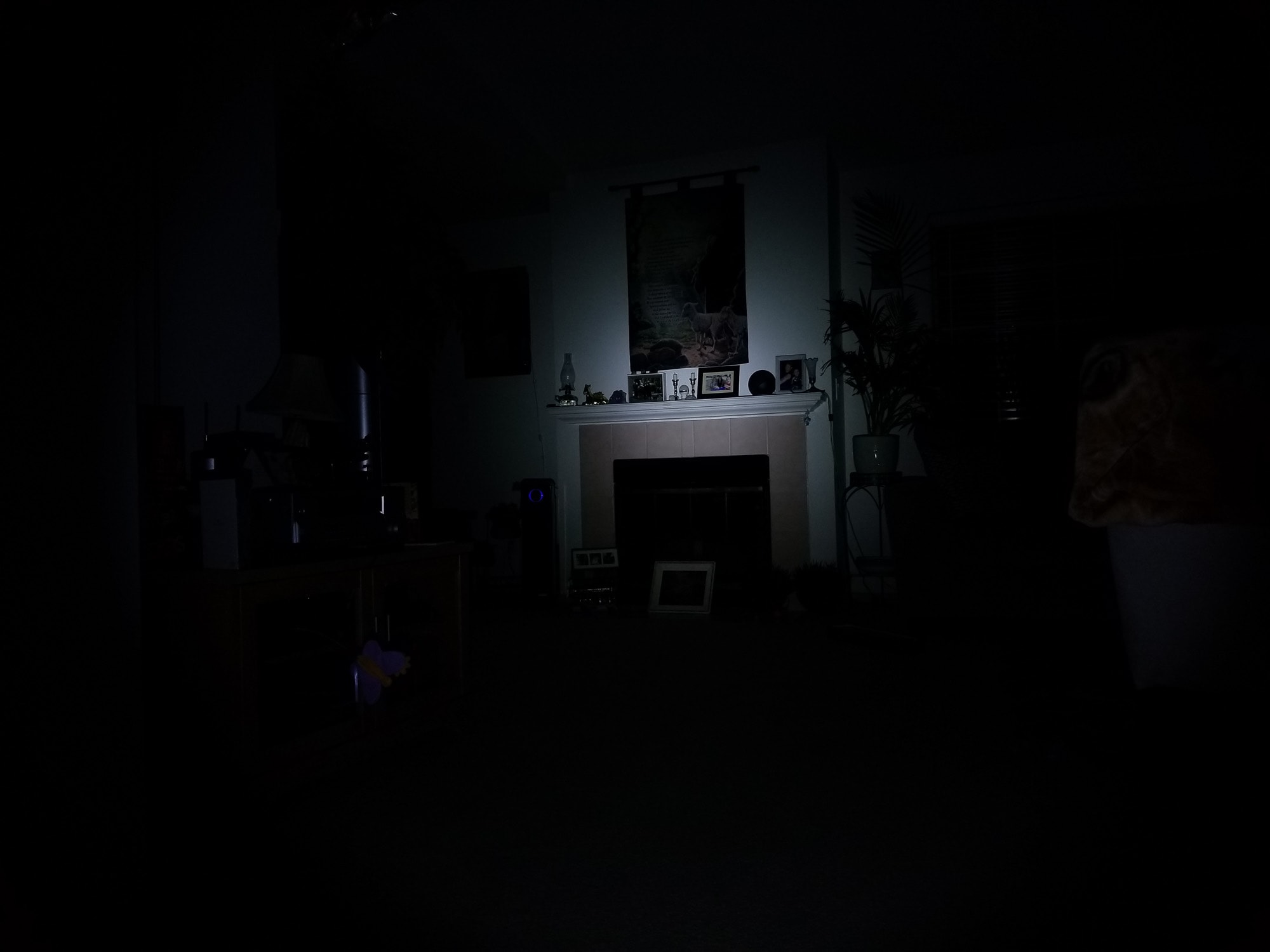
Disclaimer: we bought this flashlight with our own money. Nobody paid us to review this flashlight, nor have we been holding back on problems or defects.
Final Verdict
Pros
- Elegant, retro design
- Super simple to use
- Can use Alkalines, NiMH, and li-ion AAAs
- Beautiful tint and high CRI
Cons
- No LVP for li-ion batteries (hurts your batteries, and can even kill them!)
- Gets crazy hot on li-ions
- No low mode
- Low output
- Short runtimes
- Low build quality
Explanation on star ratings:
1: Avoid: a match would be a better choice – 2: Poor: significant defect or issues; almost unusable – 3: Average: some defects or issues; but still usable 4: Good: recommended (minor issues) – 5: Great: highly recommended

4 stars: ★★★★
I’ve reviewed a lot of flashlights over the years, some pretty amazing ones to boot, but I will say that none of them have invoked more warm and fuzzy feelings of nostalgia than this Killzone FLashlights BLF348. There’s just something about getting back to the basics, and this does just that, and does it with style (I think Doc Brown would like one of these). I like the sleek, seamless look, the stainless steel body, and no-frills ease of operation. The beam is beautiful and very useful for the intended purpose.
There’s tradeoffs of course with a simple, cheap light like this though, namely the lack of creature comforts like LVP (really important on a light compatible with li-ion batteries) and thermal regulation. Also, there’s no low mode, which would be really handy for low-light use. The quality, while not terrible, isn’t the best, especially when Olight, Skilhunt, Eagtac, and others make very nice AAA lights for not too much more money, but I digress, since that’s part of the charm of this thing. While this wasn’t the first big hit BLF collab light, it’s certainly one of the most memorable. The contributions of BLF (and CPF) enthusiasts never ceases to amaze me, and once again, it stands irrefutable that you can take a cheap, boring tube light and make it great with a simple LED swap. While there’s all kinds of SF-348 clones out there, there’s only one BLF348, and huge shoutout to Killzone Flashlights for keeping its legacy alive. Is this a flashlight everyone would love?
If you’re used to Acebeam, Fenix, Olight, ReyLight, or Skilhunt-level quality, comfort features, and refinement, you might not like the BLF348 and its sparse feature set and low-rent build persona. However, if you know what you’re buying into and want a simple to use, no-frill penlight with one of the best tints and CRI in the industry, give it a try. It’s a reminder that old things can still be new, and good! 4 stars for the Killzone Flashlights Stainless Penlight.
Buy your Killzone Flashlights with a discount
1lumen selects and reviews products personally. We may earn affiliate commissions through our links, which help support our testing.